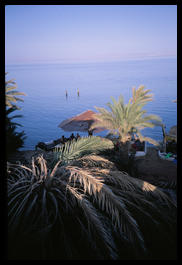 Dahab was quite a change after travel in Syria and Jordan. It's a curious mix between a backpacker haven and a resort -- sort of on it's way from the former to the latter, I think. I originally wasn't even planning on staying in Sinai, but the reports of everyone travelling the other way inidicated that it was a place to stop, relax, and eat good food after living on humous for a couple of weeks.
Dahab was quite a change after travel in Syria and Jordan. It's a curious mix between a backpacker haven and a resort -- sort of on it's way from the former to the latter, I think. I originally wasn't even planning on staying in Sinai, but the reports of everyone travelling the other way inidicated that it was a place to stop, relax, and eat good food after living on humous for a couple of weeks. 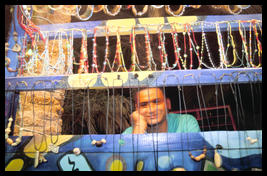 This was one of several necklace merchants selling their wares on the shores of the Red Sea. Egyptians must be pretty pencil-necked, because the necklace I got from him was just barely big enough for me to put on without choking.
This was one of several necklace merchants selling their wares on the shores of the Red Sea. Egyptians must be pretty pencil-necked, because the necklace I got from him was just barely big enough for me to put on without choking. 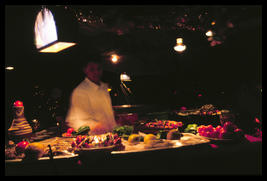 The other main institution on the main drag in Dahab are the restaurants, which all sport Bedouin-style sit on the floor seating, with low tables to match. The standard price was 20 L.E., about $4.50, for breakfast or lunch. Surprisingly good stuff, too.
The other main institution on the main drag in Dahab are the restaurants, which all sport Bedouin-style sit on the floor seating, with low tables to match. The standard price was 20 L.E., about $4.50, for breakfast or lunch. Surprisingly good stuff, too. 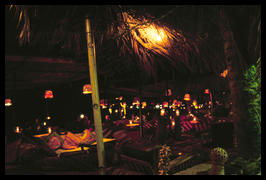 This was another of the waterfront restaurants, Aladdin.
This was another of the waterfront restaurants, Aladdin. 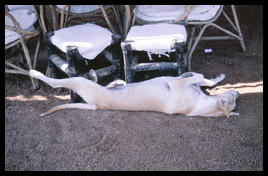 The temperature in Egypt at the start of June was scorching, and Dahab was no exception. This dog was trying to cool off a little faster by flopping over. Later on, in Luxor, I went swimming, and it was amazing when getting out of the water; withing about five minutes I was completely dry. The breeze coming off of the desert in Luxor was like a blow dryer.
The temperature in Egypt at the start of June was scorching, and Dahab was no exception. This dog was trying to cool off a little faster by flopping over. Later on, in Luxor, I went swimming, and it was amazing when getting out of the water; withing about five minutes I was completely dry. The breeze coming off of the desert in Luxor was like a blow dryer. 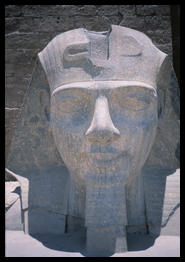 Welcome to Luxor. The trip from Dahab to Luxor was in itself something of an ordeal, but making it to Luxor was worth the extra effort. This is one of the statues guarding the main entrance to the Temple. Egyption Pharaoh after Pharaoh added on more wings, pillars, and statues to the temple in a sort of pissing contest through the ages to see who could make the addition that was the greatest tribute to Amun (ram horned, blue-skinned god, later "fused" with Ra to become Amun-Ra in the New Kingdom.
Welcome to Luxor. The trip from Dahab to Luxor was in itself something of an ordeal, but making it to Luxor was worth the extra effort. This is one of the statues guarding the main entrance to the Temple. Egyption Pharaoh after Pharaoh added on more wings, pillars, and statues to the temple in a sort of pissing contest through the ages to see who could make the addition that was the greatest tribute to Amun (ram horned, blue-skinned god, later "fused" with Ra to become Amun-Ra in the New Kingdom. 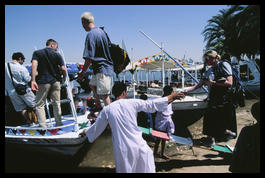 I have no pictures from the West Bank of Luxor -- the Valley of the Kings and the Valley of the Queens -- except for this, of us returning after visiting several tombs there. I highly recommend visiting the Tomb of Nefertari, which costs an exhorbitant $30. The Egyptian government is doing an impressive job of keeping it in good condition, however, and I feel like I got my money's worth. There is no glass, as there is on many other tombs of lesser quality, and the paintings look like they were made last week. While walking around in there -- as with the Dark Church in Goreme, Turkey -- it was easier to forget that you were a tourist, and it seemed like the painter was trying to communicate something about what his religion meant to him. I was only sorry that I hadn't studied better to be able to discern more of what it was he was trying to say.
I have no pictures from the West Bank of Luxor -- the Valley of the Kings and the Valley of the Queens -- except for this, of us returning after visiting several tombs there. I highly recommend visiting the Tomb of Nefertari, which costs an exhorbitant $30. The Egyptian government is doing an impressive job of keeping it in good condition, however, and I feel like I got my money's worth. There is no glass, as there is on many other tombs of lesser quality, and the paintings look like they were made last week. While walking around in there -- as with the Dark Church in Goreme, Turkey -- it was easier to forget that you were a tourist, and it seemed like the painter was trying to communicate something about what his religion meant to him. I was only sorry that I hadn't studied better to be able to discern more of what it was he was trying to say. 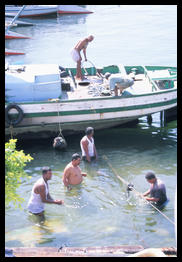 Upon reaching the East side of the Nile, I noticed these three men taking a swim in the Nile. I was surprised that they were doing so, since all of the guide books make a heavy point of the presence of schitsosomiasis in the waters of the Nile, a parasitic worm that splits its life cycle between freshwater snails and mammals. In the latter phase, which is of more concern to us, the flatworm burrows into unbroken skin, and (I quote Lonely Planet) "The infection often causes no symptoms until the disease is well established (several months to years after exposure) and damage to internal organs has become irreversile." Egyptians don't seem to have a problem with this somehow.
Upon reaching the East side of the Nile, I noticed these three men taking a swim in the Nile. I was surprised that they were doing so, since all of the guide books make a heavy point of the presence of schitsosomiasis in the waters of the Nile, a parasitic worm that splits its life cycle between freshwater snails and mammals. In the latter phase, which is of more concern to us, the flatworm burrows into unbroken skin, and (I quote Lonely Planet) "The infection often causes no symptoms until the disease is well established (several months to years after exposure) and damage to internal organs has become irreversile." Egyptians don't seem to have a problem with this somehow.Scientists are currently working on sequencing Schistosomiasis organisms, including The Institute for Genomic Research in Rockville, MD, for whom I have previously written software.
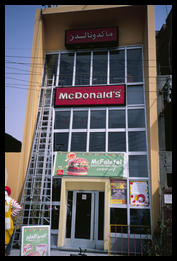 Can't get a decent fast-food vegetarian meal in the United States, but Egypt is something else. I decided to stick with the more traditional street vendors for my felafels.
Can't get a decent fast-food vegetarian meal in the United States, but Egypt is something else. I decided to stick with the more traditional street vendors for my felafels. 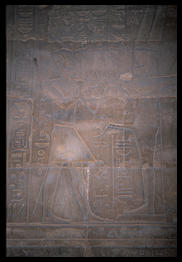 The guidebooks don't mention why the guy on the right is so excited...
The guidebooks don't mention why the guy on the right is so excited... 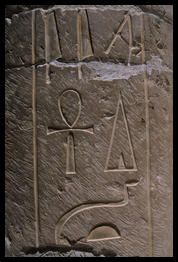 These are heiroglyphs on one of the pillars in the Temple of Karnak.
These are heiroglyphs on one of the pillars in the Temple of Karnak. 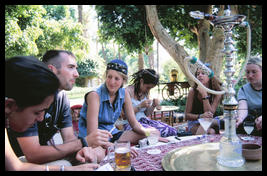 I was at this point travelling with about six others, two of whom were Englishmen that suddenly came down with an irresistable urge to find a gin and tonic. We were all staying at a $3 a night hotel, so we decided to drop in on the Old Winter Palace hotel for a drink. The Old Winter Palace is an impressive piece of work; there are fantastic gardens complete with a rookery. If you've got money to spend on a nice place to stay, I would highly recommend it.
I was at this point travelling with about six others, two of whom were Englishmen that suddenly came down with an irresistable urge to find a gin and tonic. We were all staying at a $3 a night hotel, so we decided to drop in on the Old Winter Palace hotel for a drink. The Old Winter Palace is an impressive piece of work; there are fantastic gardens complete with a rookery. If you've got money to spend on a nice place to stay, I would highly recommend it. 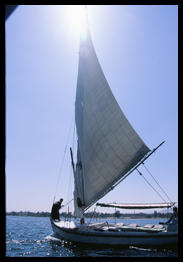 The ususual sailboats of the nile, felukahs have their masts mounted at an odd angle. Many people take several-day cruises on them, frequently from Luxor or Aswan to Cairo. I never actually got on one.
The ususual sailboats of the nile, felukahs have their masts mounted at an odd angle. Many people take several-day cruises on them, frequently from Luxor or Aswan to Cairo. I never actually got on one. 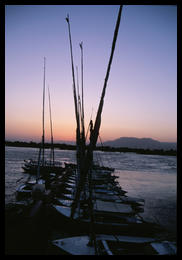 More feluccas docked in Luxor. So the sun sets on Luxor. We hop on a train to Cairo, and eleven hours later...
More feluccas docked in Luxor. So the sun sets on Luxor. We hop on a train to Cairo, and eleven hours later... 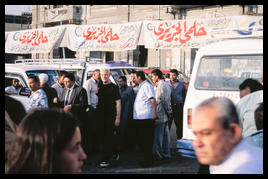 One of the English guys named Peter had recently read a list of "The World's Wst Places to Get Hassled". Bombay's central train station was definitely number one, the Pyramids of Giza, which we were planning on visiting the next day, were up there, and was the train station in Cario on the list... he couldn't rememver. This is the other Inglizi (as they are known in Arabic), Simon, who took the lead in getting a good deal on a ride from the train station to our hotel. Simon was really good at this sort of thing; I would usually give up when the haggling came down to the equivalent of fifty cents or something, but since there were now six of us, it was worth more effort. He also made a magnificent display of relunctance that saved us at least ten bucks when negotiating with the stable owners at Giza.
One of the English guys named Peter had recently read a list of "The World's Wst Places to Get Hassled". Bombay's central train station was definitely number one, the Pyramids of Giza, which we were planning on visiting the next day, were up there, and was the train station in Cario on the list... he couldn't rememver. This is the other Inglizi (as they are known in Arabic), Simon, who took the lead in getting a good deal on a ride from the train station to our hotel. Simon was really good at this sort of thing; I would usually give up when the haggling came down to the equivalent of fifty cents or something, but since there were now six of us, it was worth more effort. He also made a magnificent display of relunctance that saved us at least ten bucks when negotiating with the stable owners at Giza. 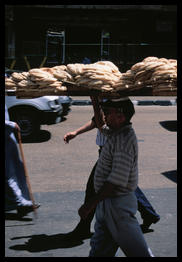 Similar to the bagel balancing boy of Istanbul, this man demonstrates one of the primary methods of moving baked goods in the Middle East.
Similar to the bagel balancing boy of Istanbul, this man demonstrates one of the primary methods of moving baked goods in the Middle East. 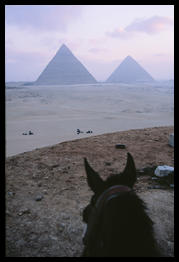 This is from after we were chased by the camel cops to the top of the trash ring around the Giza plateau. It was a pretty sunrise, but we were hoping to end up a little closer to the Pyramids.
This is from after we were chased by the camel cops to the top of the trash ring around the Giza plateau. It was a pretty sunrise, but we were hoping to end up a little closer to the Pyramids. 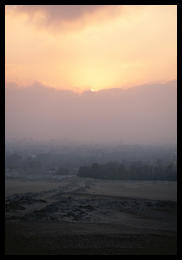 This view from the perimeter of the Giza plateau, looking into Cairo, conveys the smoky, overpopulated wildness of Cairo. Coming back to the United States after being throughout the Middle East, I was amazed at the amount of resources that each individual person is able to have here -- automobile, space to live in, food, and health care. It's a completely different way of being a human being for them, an utterly different experience.
This view from the perimeter of the Giza plateau, looking into Cairo, conveys the smoky, overpopulated wildness of Cairo. Coming back to the United States after being throughout the Middle East, I was amazed at the amount of resources that each individual person is able to have here -- automobile, space to live in, food, and health care. It's a completely different way of being a human being for them, an utterly different experience. 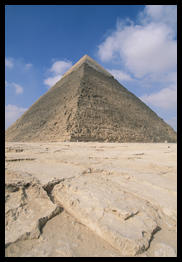 This is Khafre, or the Pyramid of Chephren. Built in 2558-2532 B.C., it is 704 feet on each side and sports a limestone cap, showing the more polished surface that used to completely cover the Pyramids of both Khufu and Khafre, his son. The Pyramids of Giza are open on a rotating basis; we we able to enter The Pyramid of Khafre. While it's worth being able to say that you were inside the pyramids, there is little of real interest inside, other than a very claustrophobic stairwell and a small internal chamber with the remains of what seems to be a tomb.
This is Khafre, or the Pyramid of Chephren. Built in 2558-2532 B.C., it is 704 feet on each side and sports a limestone cap, showing the more polished surface that used to completely cover the Pyramids of both Khufu and Khafre, his son. The Pyramids of Giza are open on a rotating basis; we we able to enter The Pyramid of Khafre. While it's worth being able to say that you were inside the pyramids, there is little of real interest inside, other than a very claustrophobic stairwell and a small internal chamber with the remains of what seems to be a tomb. 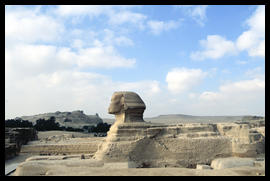 Made from the carving stones of Cheops' Pyramid, no one is sure when the Sphinx was actually constructed. Archaeologists point out the different proportion of the body and head, as well as their different erosion styles, indicate that they were made at different times. The nose's demise has been variously attributed to Turkish, French, Mameluke, and other forces; check out Andrew Warriner's page on the subject for a more in-depth analysis, and a chance to cast your own vote for whodunnit.
Made from the carving stones of Cheops' Pyramid, no one is sure when the Sphinx was actually constructed. Archaeologists point out the different proportion of the body and head, as well as their different erosion styles, indicate that they were made at different times. The nose's demise has been variously attributed to Turkish, French, Mameluke, and other forces; check out Andrew Warriner's page on the subject for a more in-depth analysis, and a chance to cast your own vote for whodunnit. 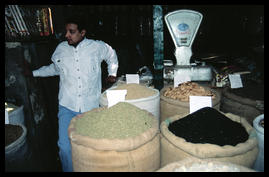 The following pictures are from our tour of the Egyptian spice market in Islamic Cairo; see my story on the subject for more information. This is one of dozens of these fellows that co-existed on the same street, seemingly selling highly similar wares, and none of them trying too hard to get us to buy.
The following pictures are from our tour of the Egyptian spice market in Islamic Cairo; see my story on the subject for more information. This is one of dozens of these fellows that co-existed on the same street, seemingly selling highly similar wares, and none of them trying too hard to get us to buy. 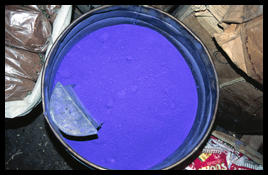 A bucket of dye made from the indigo plant.
A bucket of dye made from the indigo plant. 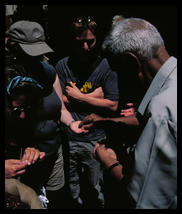 Suleyman here shows us lucky beads that were half black and half orange, and bid each of us to keep one in our wallets. He never explained why there was a large bucket of them for sale, for we each took our inidividual beads as a free sample. Mine was lucky enough to escape from my wallet recently, and I haven't seen it since.
Suleyman here shows us lucky beads that were half black and half orange, and bid each of us to keep one in our wallets. He never explained why there was a large bucket of them for sale, for we each took our inidividual beads as a free sample. Mine was lucky enough to escape from my wallet recently, and I haven't seen it since. 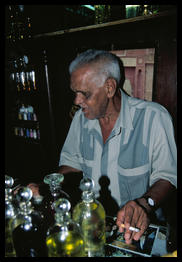 Here is Suleyman in his shop, with liter Pyrex bottles of perfumes. He limited our smelling to six different scents, since we would no longer be able to discern among them if there were more.
Here is Suleyman in his shop, with liter Pyrex bottles of perfumes. He limited our smelling to six different scents, since we would no longer be able to discern among them if there were more. 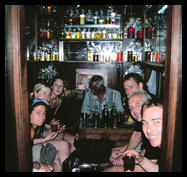 Left to Right: Valerie from Chicago; Fiona and Claire, of Nottingham; Suleyman; me; Simon and Peter, both from London. Pete is drinking tea with essence of ambergris added, a substance that sperm whales cough up when sick that is the basis for most expensive perfumes and was the main scent that most of us purchased from Suleyman.
Left to Right: Valerie from Chicago; Fiona and Claire, of Nottingham; Suleyman; me; Simon and Peter, both from London. Pete is drinking tea with essence of ambergris added, a substance that sperm whales cough up when sick that is the basis for most expensive perfumes and was the main scent that most of us purchased from Suleyman. 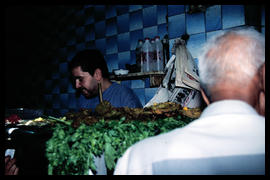 After stopping in at his shop, we went and snagged a felafel with Suleyman. True midddle eastern felafels are made with doughnut-shaped ice-cream scoops and deep fried in some kind of oil I'm probably glad remains unidentified. The result is very greasy, smells strongly of cumin, costs fifty cents, and is quite tasty.
After stopping in at his shop, we went and snagged a felafel with Suleyman. True midddle eastern felafels are made with doughnut-shaped ice-cream scoops and deep fried in some kind of oil I'm probably glad remains unidentified. The result is very greasy, smells strongly of cumin, costs fifty cents, and is quite tasty. 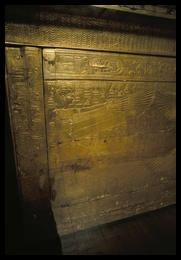 From the cairo museum, this is the innermost of four large boxes that held young king Tutankhamen's mummified body.
From the cairo museum, this is the innermost of four large boxes that held young king Tutankhamen's mummified body. 